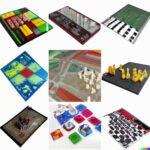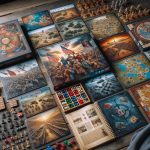Introduction
Military board games span centuries of history and have been used in war planning and preparing for battle. The earliest versions are believed to be from the 16th century, but evidence suggests that military related strategy games have been around much longer. These games give a tangible representation of battlefield dynamics, allowing soldiers to strategize, imagine, and develop their skills as leaders.
Military board games can be divided into three categories: simulated warfare (Tafl & Hnefatafl), wargaming (Kriegspiel) and battle simulations (Reiswitz). Simulated warfare is rooted in the Viking era and is based on a “defender” versus “attacker” game with rolling dice and a few other random factors thrown in. Wargames involve all aspects of military engagement, including reconnaissance, communication, transport and supply chain issues. This type of game challenges players to work around all these constraints when making critical decisions on the battlefield. Finally, battle simulations involves more play-by-play tactics for each side on the playing field–mobilizing troops along terrain elements or special abilities–and are an excellent exercise for mid-level officers who need to strategize quickly based on information they receive while leading an entire force against another opponent.
The benefits of playing these military board games are numerous. They help hone leadership skills such as planning ahead, taking risks while mitigating loss potentials, prioritizing resources and maintaining sound decision-making processes under pressure. Additionally, they provide large scale visualizations of how different strengths interact with terrain advantage or disadvantaged positions. They also introduce complexity such as weather conditions which can lead to better tactical knowledge down the road when facing unforeseen variables if/when engaging in real life battles.
Why Play Military Board Games?
There are several advantages to playing military board games. For beginners, they can offer an enjoyable introduction to the world of strategy and tactics. They can be a great way to expand knowledge of military history and principles, as well as helping in developing battle strategies and decision making skills. Experienced players will also benefit from playing these types of board games, as they have the opportunity to challenge themselves through more complex gameplay scenarios which require advanced strategizing and tactical forethought. Additionally, the highly-energized atmosphere that these types of games create can help foster relationships between friends, family members or colleagues and provide an entertaining source of entertainment for all. Overall, military board games offer something for everyone – whether you’re a beginner or experienced player ” allowing people from all walks of life to connect through shared interests and have some genuinely memorable experiences.
Types of Military Board Games
Strategy Board Games: These types of military board games involve strategic thinking and planning in order to win and achieve victory. Popular examples include Risk, Axis & Allies, and War of the Ring.
Combat Board Games: In this type of military board game, the main focus is on combat and battle. Players take control of various units and attempt to outwit their opponent while moving around a map or simulated battlefield. Generals of Gettysburg, Memoir 44 and Armada are among some popular combat board games.
War Board Games: Often reinforcing history lessons, war board games focus on recreating important wars or battles of the past. Players take charge of different historic forces while strategizing how they will ultimately gain victory. Popular titles include Gettysburg 1862 and Advanced Squad Leader series which span decades worth of conflicts from World War I to Korea to Vietnam War.
Simulation Board Games: These are more abstract war-themed games that typically involve multiple players taking on one side each in a seemingly non-violent battle for territories and resources rather than violent warfare itself. Examples include Settlers of Catan, Diplomacy, Shogun and more complex wargames such as player managed space colonies in Twilight Imperium 3rd Edition.
Historical Overview of Military Board Games
Prehistory
The history of military board games can be traced back all the way to prehistory. The Ancient Egyptians, Greeks and Romans all created specific boards and pieces used for war games. Scholars have studied ancient Egyptian reliefs and written accounts to infer some of the ways they went about practicing tactics and strategies in anticipation of battles. By simulating battle scenarios and analyzing which strategies led to victory and defeat, commanders were able to better prepare for actual combat.
Ancient Times
In Ancient China, a game called “Go” was popular amongst the upper class that featured two players who faced off against each other with black and white stones. Players could gain territory or protect their forces by moving their pieces around strategically on the game board. This game was said to teach the fundamentals of military conflict in an abstract simulation.
Medieval Times
During Medieval times there were several variations of chess developed specifically for use as a war game in Europe such as Hnefatafl from Scandinavia, Gwyddbwyll from Wales, Latura nautica from Malta, etc.. In addition there were various card decks with instructions printed on them focusing on various aspects of military strategy including siegecraft, naval tactics or terrain positioning. These decks contained specific graphics depicting different elements of a particular type warfare which would then be used randomly to play out simulated scenarios. With these cards it allowed players some flexibility within each game based on circumstance which mimicked actual battle conditions more closely than static board games like chess.
Early Modern Era Prussian strategist Carl von Clausewitz wrote an extensive treatise called On War which is still studied today by generals and political leaders alike for its insight into warfare both tactically and at a higher level of strategy.(1817) The book has been adapted into several board games as well over the years including Colombia Games’ “Clausewitz,” designed initially by Tom Dalgliesh with help from legendary wargamer John Hill . Clauswitz introduced concepts such as “Moral Combat” where individual victory depended upon not just physical strength but also political will-power allowing one forces ability to outlast another’s collective spirit.(Von Reisswitz 1824). Along side this new concepts about warfare arose modern versions comprised militaristic components such as dice , scale figurines , hexagonal spaces along with grids map tiles in order create battlefield simulations that are even more realistic then earlier games.*
Modern Era
Further advances have been made in recreating an authentic environment that adds depth when playing these war-based boardgames due increasingly sophisticated technology being developed . Some examples include GameLab’s website BoardGameOn where users compete virtually using animated pawns , tanks , planes , battleships , submarines etc across different conflicts period settings like World War I & II ; Afrika Korps ; Normandy Breakout ; Airborne drops etc (Finne2017 ). With every advancement modern recreations become increasingly richly detailed with 3D rendered battlefields or even incorporate technologies like augmented reality (A/R ) through smartphones devices allows people play locally while still interacting digitally any player worldwide instance fighting over disputed resources in outer space while watching planet Earth rotate slowly real time beneath their feet!. Whether virtual or reality based imitating medieval knights knights ancient Chinese foot soldiers shooting artillery fire up sky while future generations plan wars across galaxies, these simulations have consistently played key role educating generals teaching inexperienced soldiers basics military strategy operational execution alike throughout centuries serve important role development society today no matter shape takes form it may take.*
Popular Military Board Games
Military board games explore themes from the world’s past, present and future conflicts. From fictional battles of post-apocalyptic ruins to real-life strategy simulations of some of the world’s greatest military campaigns, these games capture the essence of combat in a varied form. Classic war board games combine elements of luck and strategy to make them both competitive and fun. Popular titles like Risk, Axis & Allies, Stratego and many more have withstood the test of time as stalwarts amongst hobby gamers. Newer releases develop new gaming systems that look to build upon existing rules while creating a battle environment that pushes the boundaries of innovation like 1939: The World War 2 Strategy Game. Tactics, resource management and unit formations are all common tools utilised in war games to keep players on their toes throughout play. Reviews provide insight into how successful each game is interpreted by its critics while ratings explicate which ones are most recommended among players themselves. Whatever your style may be; fantasy, historic or thoughtful planning ” chances are there’s a military board game match for you!
Instructional Tips for Playing Military Board Games
Military board games are becoming increasingly popular, due to their combination of strategy, tactical skill, and fun theme. They can be great fun for all ages, but many newcomers find themselves at a loss when they first sit down to play. Fortunately, there are some tips to help beginners get up and running quickly and begin enjoying one of these thrilling games!
For Beginners:
• Start small ” Military board games can have a lot of advanced rules and components, so it can be intimidating for beginners. Consider starting with an easier game that doesn’t involve as much detailed knowledge. Once you feel comfortable with the basics, move onto complex titles or other variants of the game.
• Take your time ” These games often require careful thought and strategizing so don’t get in a rush to make moves or decisions; this could cost you the game later on. Take notes if you need too as some of them may require keeping track of various pieces.
• Utilize online resources ” There are numerous video tutorials and blog articles with lots of advice on playing military board games so don’t hesitate to use these tools as needed. They’re also great for brushing up on the basics after playing multiple times!
For Advanced Players:
• Play groups ” Military board games don’t have to be played alone; many different groups exist around the world where experienced players come together for regular sessions. There will certainly be someone who has mastered your favorite game tucked away in there somewhere! Connecting with them could add an extra layer of challenge and competitiveness if you’re looking for it.
• Create house rules ” Many veteran players add their own house rules or modifiers which can make a game more difficult or exciting depending on what others like to play with. Discussing your own ideas amongst friends could lead to helpful changes that allow everyone involved to enjoy themselves more fully!
Benefits of Playing Military Board Games
Military board games provide a unique way to learn about military tactics, strategies, and operations while having fun. Playing these games encourages cognitive stimulation and promotes the development of logical thinking in those who play them. Problem-solving skills are enhanced as players use the game board to make plans and come up with solutions to situations before their opponents. It is an enjoyable way for children and adults alike to explore the different facets of warfare.
These games also foster meaningful socialization as players discuss their strategies and work together to reach a common goal. Events during game play will often stimulate meaningful conversations that build relationships around shared interests. In addition to this, they provide great opportunities for physical exercise as well. Taking turns playing pieces or rolling dice is great practice for developing motor skills, coordination, reaction time and reflexes. By competing against each other or playing alongside one another, it fosters friendships and positive competition.
Finally, military board games instill intangibles such as teamwork, critical thinking, communication skills, anticipation and probability understanding. These lessons can easily be transferred over into real life scenarios where these skills can be more greatly appreciated outside of just gaming circles. With the added benefit of entertainment value from hours of fun playtime with family and friends – it’s no wonder why these military themed board games continue to be an important part of gaming culture across all ages ranges today!
Conclusion
Military board games have been around for centuries, yet their popularity is still growing. As an entertaining and educational form of entertainment, board games provide an immersive experience that can be enjoyed by players of all ages. From strategy-focused war games to lighthearted tactical simulations, military board games bring a unique element to game night with friends or family members. With the vast amount of complexity available in today’s military board games, they are becoming increasingly popular among game enthusiasts everywhere.
In conclusion, military board games offer a great way for strategy enthusiasts, history buffs, and casual gamers to spend time together in a fun yet challenging environment. Their flexibility in terms of themes and gameplay also makes them exceptionally well-suited for both digital and physical forms of play. The future of these titles shows no signs of slowing down – digital developments such as 3D printing complement physical components to create a more engaging gaming experience. For groups seeking a dynamic and strategic experience, there simply is no better option than the many perks offered by modern military board games.

I love playing all kinds of games – from classics like Monopoly to modern favourites like Ticket to Ride.
I created this blog as a way to share my love of board games with others, and provide information on the latest releases and news in the industry.





